BMW Night Vision available in the 5, 6 and 7 Series as of May 2006
25 May 2006|34,082 views
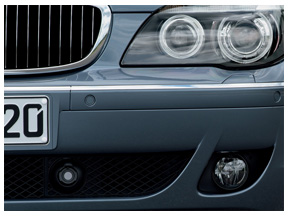 BMW Night Vision, the innovative driver assistance system introduced in the 7 Series Limousine will now be available in the 5 Series Saloon, 6 Series Coupé, and 6 Series Convertible as a factory-fitted option. BMW offers this technology for extra safety at night in several BMW models, thereby extending the availability of its revolutionary driver assistance system to a large group of customers.
BMW Night Vision, the innovative driver assistance system introduced in the 7 Series Limousine will now be available in the 5 Series Saloon, 6 Series Coupé, and 6 Series Convertible as a factory-fitted option. BMW offers this technology for extra safety at night in several BMW models, thereby extending the availability of its revolutionary driver assistance system to a large group of customers. Infra-red technology incorporating a thermal imaging camera for extra safety in the dark. Driver support and active partner protection in one.
BMW Night Vision provides a new dimension of optical perception when driving at night. A thermal imaging camera detects human beings, animals and objects in front of the car before they become visible to the human eye in the headlights. The image generated by the system is transmitted to the central Control Display within the car, presenting objects detected with increasing brightness as a function of the heat detected by the camera - and therefore making human beings and animals particularly conspicuous.
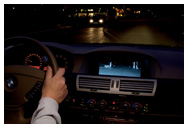 | 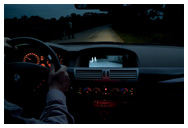 | 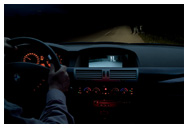 |
The thermal imaging camera covers a range of up to 300 metres or almost 1,000 feet ahead of the car. BMW Night Vision therefore offers the driver particular benefits when driving on darkened roads, down narrow lanes, through gateways leading into courtyards, and into dark underground parking spaces, significantly enhancing driving safety at night.
Together with High-Beam Assist, introduced in the 5, 6, and 7 Series, which switches the high beam on and off automatically after activation via the stalk on the steering column, and BMW Night Vision, BMW is making yet a further contribution to the enhancement of road safety by means of innovations in technology.
Both systems assist the driver in the dark who may be in a situation which requires a particularly high level of concentration. In this way BMW Night Vision and the High-Beam Assist also offer a considerable improvement of motoring comfort.
BMW opts for Far Infra-Red technology (FIR). Thermal imaging camera for enhanced detection of human beings and animals.
Conducting comparative studies and carefully observing independent scientific examinations, BMW's engineers have opted in favour of innovative far infra-red technology (FIR), which is most efficient in detecting persons, animals and objects at night. FIR offers the following benefits:
• Reduction to the essential:
Far infra-red technology uses a thermal imaging camera to highlight in particular persons, animals and objects irradiating higher temperatures. FIR intentionally does not present a detailed image of the respective traffic situation, which would only delay the recognition of a human being within the overall image. In other words, insignificant details are cancelled out and do not distract the driver.
• FIR enables the driver "to look further":
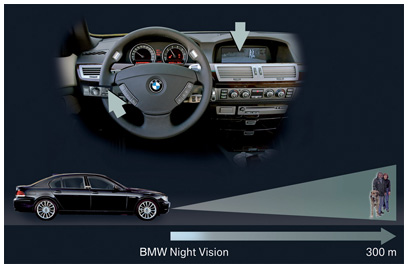 |
Covering a range of approximately 300 metres or almost 1,000 feet, FIR "looks" about twice as far as other systems. Hence, the driver is informed earlier about possible hazards - indeed, up to 5 seconds earlier at a speed of 100 km/h.
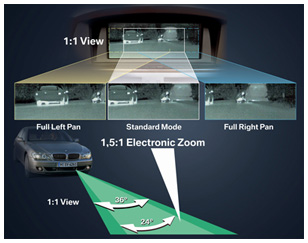 • FIR cannot be "dazzled":
• FIR cannot be "dazzled": FIR cannot be dazzled by the headlights of oncoming traffic, by traffic lights, road lights and highly reflective surfaces such as traffic signs. And vehicles with FIR technology do not dazzle each other.
Over and above the advantages offered by the FIR principle from the start, BMW has enhanced this technology by adding further functions: the image presented follows the road in a panning process and distant objects can be shown larger as a function of speed (zooming).
Convenient use of BMW Night Vision like looking in the interior mirror.
BMW Night Vision presents a high-contrast black-and-white night image to the driver on the Control Display in the middle of the instrument panel. Benefiting from FIR technology, the driver only has to briefly check out the Display in order to recognise a hazard. So using BMW Night Vision is comparable to looking into the interior mirror in the car.
Examining the new system, BMW also considered the option of presenting the image in the driver's primary field of vision, for example in the Head-Up Display or in the instrument cluster, but this option was rejected for ergonomic reasons. Tests have shown that the combination of real-life and virtual images irritates the driver and is not the best solution.
Prices for the BMW Night Vision in the 5, 6 and 7 Series start from S$7,044.
 BMW Night Vision, the innovative driver assistance system introduced in the 7 Series Limousine will now be available in the 5 Series Saloon, 6 Series Coupé, and 6 Series Convertible as a factory-fitted option. BMW offers this technology for extra safety at night in several BMW models, thereby extending the availability of its revolutionary driver assistance system to a large group of customers.
BMW Night Vision, the innovative driver assistance system introduced in the 7 Series Limousine will now be available in the 5 Series Saloon, 6 Series Coupé, and 6 Series Convertible as a factory-fitted option. BMW offers this technology for extra safety at night in several BMW models, thereby extending the availability of its revolutionary driver assistance system to a large group of customers. Infra-red technology incorporating a thermal imaging camera for extra safety in the dark. Driver support and active partner protection in one.
BMW Night Vision provides a new dimension of optical perception when driving at night. A thermal imaging camera detects human beings, animals and objects in front of the car before they become visible to the human eye in the headlights. The image generated by the system is transmitted to the central Control Display within the car, presenting objects detected with increasing brightness as a function of the heat detected by the camera - and therefore making human beings and animals particularly conspicuous.
 |  |  |
The thermal imaging camera covers a range of up to 300 metres or almost 1,000 feet ahead of the car. BMW Night Vision therefore offers the driver particular benefits when driving on darkened roads, down narrow lanes, through gateways leading into courtyards, and into dark underground parking spaces, significantly enhancing driving safety at night.
Together with High-Beam Assist, introduced in the 5, 6, and 7 Series, which switches the high beam on and off automatically after activation via the stalk on the steering column, and BMW Night Vision, BMW is making yet a further contribution to the enhancement of road safety by means of innovations in technology.
Both systems assist the driver in the dark who may be in a situation which requires a particularly high level of concentration. In this way BMW Night Vision and the High-Beam Assist also offer a considerable improvement of motoring comfort.
BMW opts for Far Infra-Red technology (FIR). Thermal imaging camera for enhanced detection of human beings and animals.
Conducting comparative studies and carefully observing independent scientific examinations, BMW's engineers have opted in favour of innovative far infra-red technology (FIR), which is most efficient in detecting persons, animals and objects at night. FIR offers the following benefits:
• Reduction to the essential:
Far infra-red technology uses a thermal imaging camera to highlight in particular persons, animals and objects irradiating higher temperatures. FIR intentionally does not present a detailed image of the respective traffic situation, which would only delay the recognition of a human being within the overall image. In other words, insignificant details are cancelled out and do not distract the driver.
• FIR enables the driver "to look further":
 |
Covering a range of approximately 300 metres or almost 1,000 feet, FIR "looks" about twice as far as other systems. Hence, the driver is informed earlier about possible hazards - indeed, up to 5 seconds earlier at a speed of 100 km/h.
 • FIR cannot be "dazzled":
• FIR cannot be "dazzled": FIR cannot be dazzled by the headlights of oncoming traffic, by traffic lights, road lights and highly reflective surfaces such as traffic signs. And vehicles with FIR technology do not dazzle each other.
Over and above the advantages offered by the FIR principle from the start, BMW has enhanced this technology by adding further functions: the image presented follows the road in a panning process and distant objects can be shown larger as a function of speed (zooming).
Convenient use of BMW Night Vision like looking in the interior mirror.
BMW Night Vision presents a high-contrast black-and-white night image to the driver on the Control Display in the middle of the instrument panel. Benefiting from FIR technology, the driver only has to briefly check out the Display in order to recognise a hazard. So using BMW Night Vision is comparable to looking into the interior mirror in the car.
Examining the new system, BMW also considered the option of presenting the image in the driver's primary field of vision, for example in the Head-Up Display or in the instrument cluster, but this option was rejected for ergonomic reasons. Tests have shown that the combination of real-life and virtual images irritates the driver and is not the best solution.
Prices for the BMW Night Vision in the 5, 6 and 7 Series start from S$7,044.
Latest COE Prices
May 2025 | 1st BIDDING
NEXT TENDER: 21 May 2025
CAT A$103,009
CAT B$119,890
CAT C$62,590
CAT E$118,889
View Full Results Thank You For Your Subscription.






















